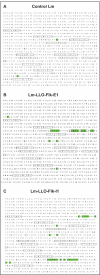Antiangiogenesis immunotherapy induces epitope spreading to Her-2/neu resulting in breast tumor immunoediting
- PMID: 24367160
- PMCID: PMC3011232
- DOI: 10.2147/bctt.s6689
Antiangiogenesis immunotherapy induces epitope spreading to Her-2/neu resulting in breast tumor immunoediting
Abstract
Targeting tumors using cancer vaccine therapeutics has several advantages including the induction of long-term immunity, prime boost strategies for additional treatments and reduced side effects compared to conventional chemotherapeutics. However, one problem in targeting tumor antigens directly is that this can lead to antigen loss or immunoediting. We hypothesized that directing the immune response to a normal cell type required for tumor growth and survival could provide a more stable immunotherapeutic target. We thus examined the ability of an antiangiogenesis, Listeria monocytogenes (Lm)-based vector to deliver extracellular and intracellular fragments of the mouse vascular endothelial growth factor receptor-2/Flk-1 molecule, Lm-LLO-Flk-E1, and Lm-LLO-Flk-11 respectively, in an autochthonous model for Her-2/neu(+) breast cancer. We found that these vaccines could cause epitope spreading to the endogenous tumor protein Her-2/neu and significantly delay tumor onset. However, tumors that grew out overtime accumulated mutations in the Her-2/neu molecule near or within cytotoxic T lymphocytes epitopes. We show here for the first time how an antiangiogenesis immunotherapy can be used to delay the onset of a spontaneous tumor through epitope spreading and determine a possible mechanism of how immunoediting of an endogenous tumor protein can allow for tumor escape and outgrowth in an autochthonous mouse model for Her-2/neu(+) breast cancer.
Keywords: Her-2/neu; Listeria; antiangiogenesis; immunoediting; immunotherapy.
Figures




Similar articles
-
Fusion to Listeriolysin O and delivery by Listeria monocytogenes enhances the immunogenicity of HER-2/neu and reveals subdominant epitopes in the FVB/N mouse.J Immunol. 2005 Sep 15;175(6):3663-73. doi: 10.4049/jimmunol.175.6.3663. J Immunol. 2005. PMID: 16148111
-
Immunoediting sculpts tumor epitopes during immunotherapy.Cancer Res. 2007 Mar 1;67(5):1887-92. doi: 10.1158/0008-5472.CAN-06-3960. Cancer Res. 2007. PMID: 17332314
-
An anti-vascular endothelial growth factor receptor 2/fetal liver kinase-1 Listeria monocytogenes anti-angiogenesis cancer vaccine for the treatment of primary and metastatic Her-2/neu+ breast tumors in a mouse model.J Immunol. 2009 May 1;182(9):5537-46. doi: 10.4049/jimmunol.0803742. J Immunol. 2009. PMID: 19380802 Free PMC article.
-
Vaccination against the HER-2/neu oncogenic protein.Endocr Relat Cancer. 2002 Mar;9(1):33-44. doi: 10.1677/erc.0.0090033. Endocr Relat Cancer. 2002. PMID: 11914181 Review.
-
Immunogenic HER-2/neu peptides as tumor vaccines.Cancer Immunol Immunother. 2006 Jan;55(1):85-95. doi: 10.1007/s00262-005-0692-3. Epub 2005 Oct 27. Cancer Immunol Immunother. 2006. PMID: 15948002 Free PMC article. Review.
Cited by
-
Clinical development of Listeria monocytogenes-based immunotherapies.Semin Oncol. 2012 Jun;39(3):311-22. doi: 10.1053/j.seminoncol.2012.02.008. Semin Oncol. 2012. PMID: 22595054 Free PMC article. Review.
-
Attenuated Listeria monocytogenes: a powerful and versatile vector for the future of tumor immunotherapy.Front Cell Infect Microbiol. 2014 May 12;4:51. doi: 10.3389/fcimb.2014.00051. eCollection 2014. Front Cell Infect Microbiol. 2014. PMID: 24860789 Free PMC article. Review.
-
Listeriolysin O as a strong immunogenic molecule for the development of new anti-tumor vaccines.Hum Vaccin Immunother. 2013 May;9(5):1058-68. doi: 10.4161/hv.23871. Epub 2013 Feb 11. Hum Vaccin Immunother. 2013. PMID: 23399758 Free PMC article. Review.
-
Anti-angiogenesis immunotherapy.Hum Vaccin. 2011 Sep;7(9):976-81. doi: 10.4161/hv.7.9.16407. Epub 2011 Sep 1. Hum Vaccin. 2011. PMID: 21860259 Free PMC article.
-
Listeria monocytogenes as a Vector for Cancer Immunotherapy: Current Understanding and Progress.Vaccines (Basel). 2018 Jul 25;6(3):48. doi: 10.3390/vaccines6030048. Vaccines (Basel). 2018. PMID: 30044426 Free PMC article. Review.
References
-
- Harzstark AL, Small EJ. Immunotherapy for prostate cancer using antigen-loaded antigen-presenting cells: APC8015 (Provenge) Expert Opin Biol Ther. 2007;7:1275–1280. - PubMed
-
- Seavey MM, Pan ZK, Maciag PC, et al. A novel human Her-2/neu chimeric molecule expressed by Listeria monocytogenes can elicit potent HLA-A2 restricted CD8-positive T cell responses and impact the growth and spread of Her-2/neu-positive breast tumors. Clin Cancer Res. 2009;15:924–932. - PubMed
Grants and funding
LinkOut - more resources
Full Text Sources
Other Literature Sources
Research Materials
Miscellaneous

